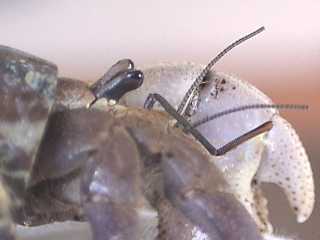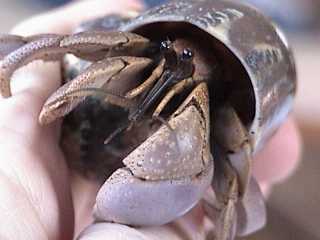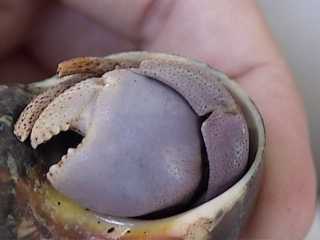
Coenobita
brevimanus
Good heavens, look at that CLAW!
The name "Indonesian crab" is misapplied
to these crabs, for though they do come from the Pacific and Indonesian area,
all the hermit crabs featured on this page do, too! It is more accurate to refer
to them by their scientific name, which is what I'll do here.
Coenobita brevimanus is the most terrestrial of all land hermit crabs, except the giant robber crab (Birgus latro). C. brevimanus' body is heavily armored and all surfaces are covered with a thick exoskeleton to help minimize water loss through evaporation. C. brevimanus is not difficult to distinguish from other hermit crab species. Look for narrow, dark, tubular eyestalks and an outsized lilac-colored purple pincher. The picture at the right shows clearly the long, thin eyestalks that are unique to this species.
C. brevimanus also has an impressive and distinctive
"front door" of a big claw. The left claw of C. brevimanus looks,
in the words of one of my friends, "Like a claw from a crab two sizes larger
was tacked on." The claw is usually presents when the crab is in the shell
as a uniform lilac color.
C. brevimanus also has a unique leg that wraps around the top of that big claw.
The crab's leftmost walking leg has a groove in the last joint, made seemingly
to provide a very tight seal against the elements.
 Special
Needs. C. brevimanus does have some special needs, as hermit crabs go.
First of all, since they are the most terrestrial of all land hermit crab species,
they do not like to get wet. So please do not bathe them more than once
a month. Since they don't like their feet wet, please provide them with a place
they can climb to if they want to get off moist substrate. They enjoy digging
if the substrate is not sloppy wet.
Special
Needs. C. brevimanus does have some special needs, as hermit crabs go.
First of all, since they are the most terrestrial of all land hermit crab species,
they do not like to get wet. So please do not bathe them more than once
a month. Since they don't like their feet wet, please provide them with a place
they can climb to if they want to get off moist substrate. They enjoy digging
if the substrate is not sloppy wet.
To help your C. brevimanus' retain water and keep their hydration optimal, please provide them with a dish of saline water. The area they come from has many islands, some of which do not have fresh water and C. brevimanus is specially adapted to deal with this. We don't to put them through unnecessary hardship, however, so please give them both fresh and salt water.
Molting. It's been my experience that C. brevimanus molts well in Forest Bedding. I have not had them molt in sand yet simply because
I have always had mine on Forest Bedding. My other exotic species however have molted well using the general molting method
described on the Molting page so I suspect that C. brevimanus would find it acceptable. When it comes
to C. brevimanus' molting habits, they are very similar to those of the purple
pincher or Ecuadorian crabs. They will dig under and molt and then come back
up when they are ready.
Temperament. C. brevimanus is like most hermit crabs in the way that each crab has its own temperament. Some come out for you readily, others will not. Some want to pinch whatever they can find, others have no interest in pinching. Some people (me included) have had a problem with C. brevimanus being overly aggressive towards other hermit crabs, even crabs of its same species. Watch and be sure that no crabs are denying others access to food or water. If you notice that you have an aggressive C. brevimanus, please take steps to prevent trouble. Add another food dish -- a small one is perfect. Make sure there are plenty of shells available for all the crabs.
C. brevimanus has a unique defensive posture it will take if it feels threatened. It will raise its two first walking legs out to either side of it, like wings, to make itself look bigger and more threatening. The crab will then push out quickly with its two claws, trying to push away anything in front of it. I call this posture "The Stork," (ala The Karate Kid) and I keep an eye on crabs that I frequently see "storking" others.Compatibility. I have been keeping my C. brevimanus crabs in a crabitat along with all my Ecuadorians and other exotic species. Aside from some initial "storking" episodes, they appear to get along well. Keep an eye on the crabitat initially after introducing ANY new species, to make sure there is no trouble.
Further Research:If you would like to view more pictures and infomation about identifying this species of hermit crab, please check out the Links page.
Home Page/ Behavior & Aggression/Basic Care/Chirping/Convention Happenings/ Sexing/FAQs/Food & Feeding/My Links/Molting/Nocturnal Behavior/Shells & Shell Pictures/Species Identification/About Me